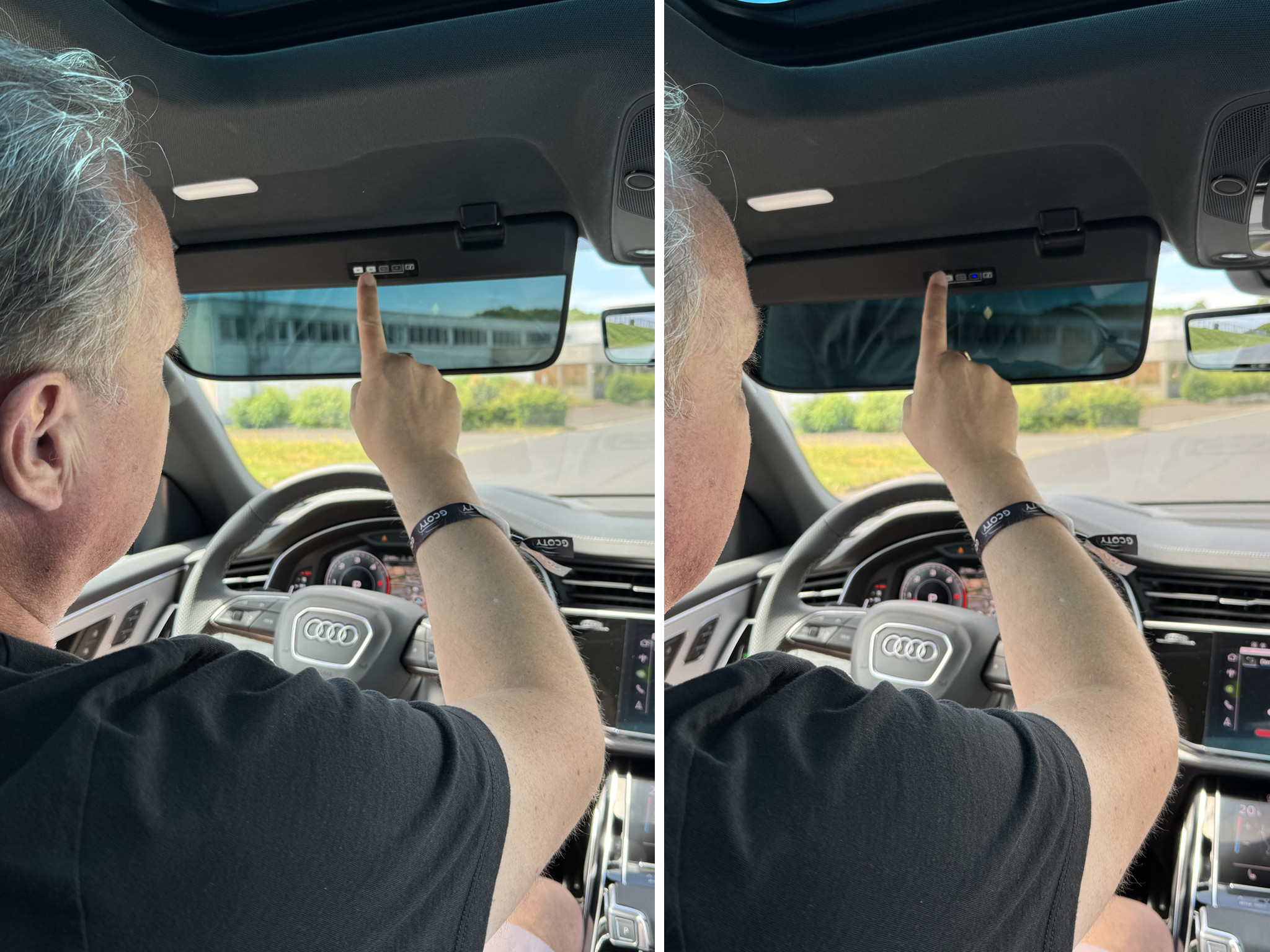
Have you ever been driving down the road at night and been temporarily blinded by a car behind you or coming towards you with super-bright headlights? You’re not alone. According to research by the RAC, 95 per cent of drivers say that some or all car headlights are too bright these days, with a quarter of all drivers driving less because of an increasing amount of glare.
Across Europe, a study by the FIA – which as well as running F1 and motorsport represents 140 motoring clubs and organisations – revealed that 71 per cent of drivers find glare intolerable or annoying, while 51 per cent pinch their eyes shut or close them briefly.
Glare, it seems, is in the spotlight. The UNECE (United Nations Economic Commission for Europe) recently set up a task force to focus on glare and how it can be reduced.
US firm Gentex has been dealing with glare for years. I tried a new technology at the German Car of the Year event that seeks to reinvent the sun visor to reduce glare from the sun, without reducing visibility.
Gentex is more famous for two things: it makes most of the world’s auto-dimming rear-view mirrors, shipping nearly 50 million of them in 2024. If you’ve ever flown on a Boeing 787 Dreamliner, it makes the dimming side windows that do without the traditional pull-down sunblind and replaces them with electrochromic glass that dims at a touch of a button.

It's that electrochromic tech that features in the clever sunshades in our picture, and is set to revolutionise panoramic sunroofs soon, too.
In the dimmable sunshades, driving on a sunny day, I could leave the sunshades down with the lowest level of tinting selected and still get full visibility across the entire screen. I could then choose from four different shades of darkness depending on the strength of the sunlight, or in some cases a sensor could detect the sun load and dim the sunshades automatically.
I tried the tech in an Audi Q8, and it felt like a much more premium solution than the solid, often cardboard, sunshades we’re used to that only offer complete obscuration of part of the windscreen. Just in case you’re the sort of person who relies on a car’s vanity mirror, Gentex’s solution is for the whole sunshade to turn into a mirror at the touch of a button, complete with a light that comes on in the car’s headlining at the same time. Clever.
So that’s glare from the sun sorted, and glare from behind taken care of, but what about glare from approaching cars’ headlights? My companion on my test drive to try out the clever sunshades was Craig Piersma, VP of marketing and corporate communications for Gentex, who clearly has a passion for dealing with glare.
“Drivers globally are dealing with an increase in roadway glare due to new headlight technologies, trucks and SUVs with higher-mounted headlights, an increase in night time driving and an aging population more susceptible to glare,” Piersma told me.

“When glare reaches the eye, it bleaches the retina's light receptors, creating a flash blindness that hampers forward vision, slows reaction time, and increases stopping distances.
“Glare from trailing headlights can be minimised with interior and exterior automatic-dimming rear view mirrors, which automatically darken to the precise level necessary to eliminate glare. Mitigating oncoming glare is more complicated.
“In Europe, the UNECE recently launched a task force to study the issue, but until there's a better fix, drivers should briefly look down and away as coming headlights approach, keep your windscreen clean to prevent light scattering, and properly clean and aim your own headlights as a courtesy to other drivers.”
An increasing number of car makers are fitting fancy LED headlights. And headlights, along with OLED or TFT displays, are not only having to light the road ahead, but are also potentially being tasked with providing information to pedestrians and other road users when, for example, a car is being driven autonomously. They could even soon be displaying instructions to drivers on the road surface ahead.
The latest Matrix LED technology means that these headlights can mask areas where a car detects oncoming traffic to avoid blinding other drivers, but this tech is only just filtering down to mainstream models. More commonplace are automatic high-beam systems that switch from dipped to main beam in the dark, but some of these setups can be slow to react to an oncoming car.
There’s no doubt that better lighting means better visibility and better safety. But it’s a two-way street – as much as you might be able to see better with your super-duper new headlights, someone coming towards you might find it really difficult. Glare means that some drivers might find it difficult to judge distance, positioning and approaching speed.
So what can be done? It’s an increasing problem, as Craig Piersma points out. But his advice is sound: if you’re worried you’re going to get blinded by oncoming lights, look away very briefly. Also keep your windscreen clean and make sure your headlights are properly maintained.
During the day and in most weathers, I rely on my driving glasses – these are sunglasses (also available with prescriptions) that reduce glare, highlight certain colours and improve contrast and definition. My favourites are called Serengeti Drivers and I also use them in bad weather when it’s important to be able to pick out the red of brake lights of the cars in front of you.
As for night time glare, it’ll be interesting to see what recommendations UNECE comes back with, but I think it’s a combination of better light tech and perhaps better glass tech – maybe the next generation of anti-glare windscreen could be on the way.
Hyundai set to reveal new high-tech Ioniq model at Munich motor show in September
Octavia goes electric as Skoda runs out of names for its new EV push
The petrol car that thinks it’s an EV
The petrol car that thinks it’s an EV
Citroen e-C3 review: Cheap family EV is perfect for British roads
Best family electric cars 2025: Practical seven seater EVs tested
Think electric cars are expensive? My new EV costs me less than a couple of posh coffees a day







